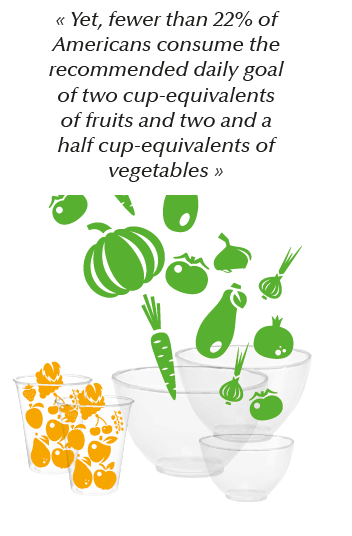Improving Fruit and Vegetable Consumption among Overweight and Obese Adults
Dietary Approaches to Weight Change
Rates of obesity, which is defined as a body mass index (BMI) of 30 kg/m2 or higher, are increasing in the U.S. Close to one-third of all children and adolescents and over two-thirds of all adults are overweight or obese. The concern regarding the rising rates of obesity are the negative health effects, including hypertension, stroke, coronary heart disease, type 2 diabetes mellitus, and various cancers. Changes in dietary intake, including increased fruits and vegetables consumption, can be helpful in promoting weight loss in overweight and obese individuals. Yet, fewer than 22% of Americans consume the recommended daily goal of two cup-equivalents of fruits and two and a half cup-equivalents of vegetables. Lower than recommended fruit and vegetable consumption has been seen repeatedly in different adult cohorts with overall consumption in some adult cohorts actually decreasing over time.
Nutrition Education and Fruit and Vegetable Consumption
A recent investigation of the effectiveness of a community-based fruit and vegetable education program and provision of fruits and vegetables on changes in fruit and vegetable consumption among overweight and obese adults yielded interesting results. The adults were randomly assigned to one of three intervention groups: the control group received no intervention, the education group attended weekly nutrition lessons promoting fruit and vegetable consumption, and the fruit and vegetable group attended weekly nutrition lessons and received samples of fruits and vegetables daily for 10 weeks. Semi-quantitative food frequency questionnaires and three-day food records were used to assess fruit and vegetable consumption.
At the beginning of the study, none of the participants were consuming the recommended daily amounts of fruits and vegetables. Increases in the frequency of consuming fruits and vegetables following the intervention were reported among participants in the two intervention groups, but not in the control group. However, no additional increases were noted in fruit and vegetable group participants compared to education group participants, suggesting that nutrition education, but not samples of fruits and vegetables, may have contributed to success in increasing fruit and vegetable consumption among participants. Even with increases in consumption reported among education and fruit and vegetable group participants, actual consumption of fruits and vegetables was still below current recommendations at the end of the study.
Throughout the nutrition education intervention, emphasis was placed on encouraging participants to replace energydense, nutrient-poor foods previously consumed with fruits and vegetables. This was emphasized in order to promote increased consumption of fruits and vegetables while maintaining and/or decreasing overall caloric intake. One suggestion offered to participants was to consume fruits and vegetables as a snack. Since snack foods tend to be high in energy density while low in nutrients, substituting fruits and vegetables can help to both increase fruit and vegetable intake while decreasing consumption of less nutritious foods.
While the authors’ hypothesis that nutrition education and nutrition education with the provision of fruits and vegetables would have a differential effect on changes in frequency of fruit and vegetable consumption over time compared to no intervention was not supported by the study results, the increased weekly frequency of fruit and vegetable consumption among those who received the intervention was positive.
Recommendations
With over 37% and 22% of Americans consuming fruits and vegetables less than once per day, and rates of overweight and obesity rising, recommendations include to both increase consumption of fruits and vegetables and decrease consumption of high-energy, nutrient-poor foods. If maintained as part of an overall healthy lifestyle change, improvements in fruit and vegetable consumption may contribute to improved nutrient intake, weight loss, and decreased disease risk in adults. Future studies should include post-intervention follow ups to determine the effectiveness over time of nutrition education on changes in fruit and vegetable consumption

Based on: Wagner, M.G., Rhee, Y., Honrath, K., Blodgett Salafia, E.H., Terbizan, D. (2016). Nutrition education effective in increasing fruit and vegetable consumption among overweight and obese adults. Appetite, 100, 94-101.
